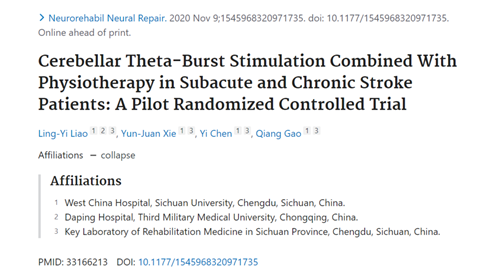
In November 2020, the clinical research of “Cerebellar Theta-Burst Stimulation Combined With Physiotherapy in Subacute and Chronic Stroke Patients: A Pilot Randomized Controlled Trial” was published on the top journal Neurorerehabilitation and Neural Repair.
The balance and motor dysfunction secondary to stroke seriously affect patients’ walking function, daily activities and quality of life. Cerebellum plays an important role in adaptive learning and the initiation of voluntary movement, which is related to relearning simple exercise strategies for stroke patients. In recent years, the application of cerebellar non-invasive brain stimulation has become the focus and hotspot in the rehabilitation of stroke patients. Intermittent theta-burst stimulation (iTBS), a new neuroregulatory technique, can promote neuroplasticity in stroke patients, thus improving their balance and motor function. Therefore, in order to determine the effect of cerebellar ITBS on the balance and motor function and the corticospinal excitability of patients with subacute and chronic stroke, Prof. Gao Qiang’s team designed and conducted a single-center, randomized, double-blind, placebo-controlled clinical trial, which included 30 post-stroke hemiplegic patients.
The results show that the cerebellar iTBS combined with the conventional stroke physical therapy can effectively improve the balance and motor function in post-stroke hemiplegic patients in a short period of time, with the curative effect being better than that of conventional stroke physical therapy alone, indicating that the cerebellar iTBS can be used as an auxiliary intervention measure for post-stroke rehabilitation therapy. This study provided not only a basis of evidences for promoting the clinical application of iTBS, but also a new clinical strategy for rehabilitation treatment of stroke patients.